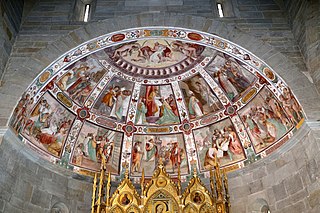
The Sanctuary of Saint Michael the Archangel is a Roman Catholic shrine on Mount Gargano, Italy, part of the commune of Monte Sant'Angelo, in the province of Foggia, northern Apulia. It has the dignity of a minor basilica.

May 7 - Eastern Orthodox Church calendar - May 9

Manfredonia is a town and commune of Apulia, Italy, in the province of Foggia, from which it is 35 kilometres northeast by rail. Manfredonia is situated on the coast, facing east, to the south of Monte Gargano, and gives its name to the gulf to the east of it. As of 2017 its population was 56,932.

February 6 - Eastern Orthodox liturgical calendar – February 8

Petronius was bishop of Bologna during the fifth century. He is a patron saint of the city. Born of a noble Roman family, he became a convert to Christianity and subsequently a priest. As bishop of Bologna, he built the Church of Santo Stefano.

The Archdiocese of Manfredonia–Vieste–San Giovanni Rotondo is a Latin Church non-Metropolitan Archdiocese of the Catholic Church in the civil province of Foggia, in Apulia, south-eastern Italy, which is part the ecclesiastical province of the Metropolitan Archdiocese of Foggia-Bovino

Siponto was an ancient port town and bishopric of Magna Graecia in Apulia, southern Italy. The town was abandoned after earthquakes in the 13th century; today the area is administered as a frazione of the comune of Manfredonia, in the province of Foggia. Siponto is located around 3 km south of Manfredonia.

Saint Caesarius of Terracina was a Christian martyr. The church of San Cesareo in Palatio in Rome bears his name. He is venerated as a saint in the Eastern Orthodox Church and Roman Catholic Church, with a feast day on 1 November.

Perugia Cathedral, officially the Metropolitan Cathedral of St. Lawrence, is a Roman Catholic cathedral in Perugia, Umbria, central Italy, dedicated to Saint Lawrence. Formerly the seat of the bishops and archbishops of Perugia, it has been since 1986 the archiepiscopal seat of the Archdiocese of Perugia-Città della Pieve.
Andrea Miglionico was an Italian painter of the late-Baroque period.

Saint Romulus of Fiesole was bishop of Fiesole during the 1st century. He is venerated as the patron saint of Fiesole, Italy. Romulus was probably a local deacon, priest, or bishop of the 1st century.

Eleutherius, also written as Eleutherus, Eleuterus and Eleftherios; sometimes called Liberalis or Liberator Greek: Ἐλευθέριος) and his mother Antia, or Anthia are venerated as Christian saints and martyrs in Greece and Italy.

Saint Sabinus of Canosa, venerated as a saint in the Roman Catholic church, was bishop of Canosa di Puglia from 514.

Manfredonia Cathedral is a Roman Catholic cathedral in Manfredonia in Italy, dedicated to Saint Laurence of Siponto, one of the patron saints of the city. Formerly the archiepiscopal seat of the Archdiocese of Siponto, later known as Manfredonia, it is now the seat of the Archbishop of Manfredonia-Vieste-San Giovanni Rotondo.

The Basilica of Santa Maria Maggiore di Siponto is a church approximately three miles south of Manfredonia, Apulia, southern Italy. Once the cathedral of the city of Siponto, it received the status of Basilica Minor in 1977; it is dedicated to the Holy Virgin of Siponto.
Saint Pelinus or Pelinus of Brindisi was a Basilian monk, later bishop of Brindisi in Italy, martyred at Corfinio and made a saint in 668. His feast day is Dec. 5.

Aquino Cathedral is a Roman Catholic cathedral in Aquino, Lazio, Italy. It is dedicated to Saints Constantius of Aquino and Thomas Aquinas.

The Liber de apparitione Sancti Michaelis in Monte Gargano is a composite 9th century hagiographical text by an anonymous author containing the foundation myth of the Sanctuary of Monte Sant'Angelo, also known as Mont Gargano, on Mount Gargano, Italy, in northern Apulia. It contains record of the first known appearance of Saint Michael the Archangel in western Europe after the transmission of his cult from the Greek East.

Priscus of Nocera was the first bishop of Nocera, patron saint of the city of Nocera Inferiore and of the diocese of Nocera Inferiore-Sarno.














